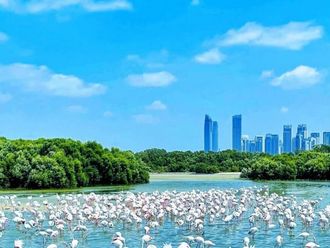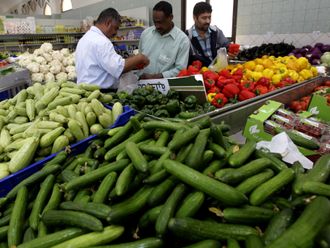
Societal unrest and strategic manoeuvring over water have pervaded the Middle East for a long time now, pushing people to act aggressively to secure the most precious natural resource.
The River Jordan is at the heart of the siege of Gaza Strip; Iraq, Syria and Turkey are close to war over their shared rivers — the Euphrates and Tigris; and Egypt and Ethiopia have increased their threatening posture over the construction of the Great Ethiopian Renaissance Dam in the Blue Nile over the years.
So are we finally witnessing the first flashes of water wars?
To put it simply: yes.
Behind the brutal slaughter of Daesh (the self-proclaimed Islamic State of Iraq and the Levant) in Iraq and Syria, there lies a battle for water. In recent months, many of the key battles in Iraq’s civil war have been over large dams.
The Mosul Dam, the largest in Iraq that controls most of the country’s water and power resource, is the key strategic battleground in northern Iraq between Daesh and Kurdish and Iraqi forces.
“Water is increasingly being used as a weapon of war in the Middle East, which is disconcerting. While Isis [Daesh] originally grew out of the American occupation of Iraq, water shortages have contributed to its rise. Now they are interested in controlling water resources, as many people die of thirst in Iraq. Not just in the Middle East, look at what happened in Darfur, which had everything to do with water,” says Karen Piper, a professor at the University of Missouri in US who spent seven years investigating the water landscape across six continents — covering America, Chile, South Africa, India, Iraq and Egypt for her book “The Price of Thirst: Water Scarcity and the Coming Chaos”, sketching a frightening portrait of the water scarcity, privatisation of water and rise of extremism.
While the recent UN report warned that world could suffer a 40 per cent shortfall in water in just 15 years leading to crops failure, breakdown of ecosystems, collapse of industries, disease and poverty, and violent conflicts over access to water becoming more frequent, Sana’a offers us a glimpse of the scenario.
In four years time, 2.6 million residents of Sana’a will be forced to leave the city due to water scarcity; Yemeni government officials estimate that local disputes over land and water lead to 4,000 deaths every year, as the country is hurtling towards civil war.
“In the Middle East, water cut-offs and dam takeovers are being used to apply political pressure or to manipulate. The battle over Mosul Dam has been raging for years, and whoever controls the dam can threaten downstream users with drought or floods.
“Turkey is aggressively promoting agricultural development near the Syrian and Iraqi borders, bringing in Turkish farmers to displace Kurds, and at the expense of struggling farmers outside of Turkey. It’s no wonder that Turkey now has to deal with Isis [Daesh],” says Piper, exposing the immense scope of the water crisis — a man-made emergency.
In “The Price of Thrist”, she looks at the events leading up to the Daesh invasion in Iraq, including problems of water availability in both Iraq and Syria, how water facilities were attacked in Iraq during the coalition-led Gulf War of 1991 that have not been repaired to this day, examines the long history of corruption in the US-led reconstruction, as well as Turkey’s intransigent position on water, which have both led to the present situation.
While analysts say that the intense drought of 2007-2009 helped trigger Syria’s civil war — which has till date killed more than 220,000 people and displaced more than 11 million, Piper says, “It is interesting how the term ‘drought’ is used. Sometimes it is used when there has been a change in water allocation rather than a shortage in rainfall. In the case of the Syrian drought, there was less rainfall, but there were also other factors causing water shortages, such as Turkey’s position on the GAP dams. This is when Turkey was intentionally ramping up irrigation on its borders and so shutting it down in Syria. So both factors led to a desperation not seen before in Syrian farming regions, which Daesh then conveniently exploited.”
Countries along the Nile, Tigris and Euphrates are hotspots for potential social unrest or worse, as over the past decade, Egypt, Ethiopia and Sudan are in a bitter war of words over the construction of the Great Ethiopian Renaissance Dam (known as Gerd) in the Blue Nile.
While these are challenging times for these countries, all is not lost. With more than 90 per cent of the world’s population living in countries that share river and lake basins, and 148 countries sharing at least one trans-boundary river basin, governments must not lose sight of the opportunities that water offers as a source of cooperation, Piper says.
Case in point: the 1960 Indus Water Treaty between India and Pakistan survived three wars and remains in force today. “One can only hope that disputes between countries will be worked out through treaties rather than violence.”
Another issue, Piper says, that threatens to undermine the long-term prosperity is ruthless dam building. “The dam-building spree is misguided since it causes enormous water losses through evaporation. Mosul dam is on the verge of collapse. Given the constant conflict around the dam, how does one maintain it? And what happens when it collapses?
“As for the Bekhme dam, it was once known as ‘Saddam’s Dam’ because Saddam Hussain intended to wipe out the Barzani homelands by flooding them out. The fact that the Kurds now want to rebuild this dam is hugely ironic, especially since it will bury their own history. The dam will flood Neanderthal bones and artefacts in the region that could potentially change our understanding about the origins of the human species. Dam-building is a big water grab that could lead to war.”
A recent UN report predicts global water demand will increase 55 per cent by 2050. Ironically, Piper says, many Middle East countries are burning it to pump dry aquifers and desalinate seawater to sustain farms and modern cities in the desert. “Saudi Arabia, for instance, is in a real race to the bottom in terms of which resource it will deplete first: oil or water.”
What is required, she says, is integrated water resource management that takes into account who needs what kind of water, as well as where and how to use it most efficiently.
Talking about the revival of indigenous water systems, calling dams “evaporators” for the amount of water loss they cause in desert regions, Piper says, “The qanat and karaz systems in the Middle East are amazing innovations; they carry water underground from the mountains and so avoid evaporative loss. In India, there are visually stunning wells with stone steps and even summer houses inside, which were once centres for the community. But during colonisation they were neglected or destroyed. Today, nonprofit groups are attempting to revamp these systems before they completely crumble.”
While the need for innovations in efficient water conservation has never been greater, Piper says “conservation” need not be defined in terms of per capita domestic consumption, which does not include highly wasteful industrial and agricultural water usage. “The model that defines the poorest countries as being the best at ‘conserving water’, is like arguing that someone who is starving is ‘conserving food’.”
Meanwhile, a few countries are making new strides in the pursuit of better and more accessible water, as well as working to legally protect water as a source of life for humans and non-humans.
“New Zealand and Costa Rica are worth watching. In New Zealand, the government recently legally defined a certain river as a ‘person’ with all the rights of personhood. The government has also been working closely with indigenous Maori to change water laws and has granted them guardian status over certain rivers. In Costa Rica, 26 per cent of the country has been set aside for watershed and biodiversity protection. The government is working hard to develop sustainably and so far is succeeding quite well, with low poverty rates, excellent gender equality, and a clean environment. Costa Rica also has the goal of being the first carbon neutral country in the world by 2021,” Piper says.
Dismally, on the other side, the fast-growing economic giants such as China and India face imminent tipping points from unsustainable water practices.
“Both countries are quickly losing their ‘freshwater bank’, the Himalayan ice caps, leading to intense flooding-drought cycles. At the same time, both countries plan to construct enormous and expensive water diversion projects that will only make things worse. The River Interlinking Project in India and the South-North Water Transfer Project in China will destroy river systems, displace people and desertify new regions.”
Clean, safe drinking water is scarce: 750 million people around the world do not have clean water. Though access to safe drinking water is a human right, Piper feels the UN-mandated minimum of 50-100 litres per person per day is not enough. “This is only for drinking and hygiene. If you consider that it takes around 9,000 litres to raise one chicken, then 50-100 litres is clearly not enough per day to survive. It should be closer to 4,000 litres.”
By and large, the dominant view globally is that water prices must increase to fund the expansion of water services delivery networks, and that will also help increase public consciousness.
Even the UN report suggests several changes that nations can make to deal with water shortages, from finding new ways of recycling waste water to increasing water prices.
So, charging for water has its benefits?
“It’s fine to meter water usage and collect fees for its delivery. Those fees can then go back into maintenance. On the other hand, the water industry is getting rich off the poor, people without clean water. The World Bank is enabling them by funnelling taxpayers’ money to water corporations. If the Bank wants to maintain its legitimacy, it should start providing loans to public utilities that are not looking for an angle to make money,” says Piper, adding that Chile was the first country to privatise 100 per cent of its water supplies, with a single company having monopoly over the country’s water supplies in what is now called “the theft of the century”.
Stating that a global scarcity of vital resources due to unbridled consumption and the onset of extreme climate change, including heat waves, droughts reducing the flow of many vital rivers, has already started a tidal wave of unrest and human chaos, Piper says, “The question is whether or not we can stop ourselves from this destructive behaviour, since human habits seem to run deep. Today, islands are sinking, deserts are growing, the Arctic is melting, oceans are dying, and massive methane releases are exploding from the Arctic permafrost. In the future, there will be mass migrations as both the agricultural and fishing industries collapse. And that’s the good news. The bad news is that climate change may already be irreversible. The next few decades will be interesting to watch, to say the least. There will be food and water shortages in the Middle East, North Africa, Australia, and the American Southwest. Wealthier countries will have a larger buffer against disasters, and climate change impacts will also vary by region. No one knows the timescale in which these changes will occur; we only know they have started.”
Suparna Dutt-D’Cunha is a writer based in Pune, India













